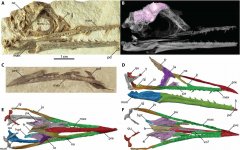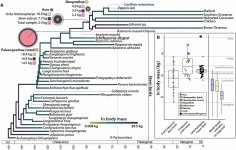Fred Ruhe
Well-known member

Christopher R. Torres, Mark A. Norell and Julia A. Clarke, 2021
Bird neurocranial and body mass evolution across the end-Cretaceous mass extinction: The avian brain shape left other dinosaurs behind
Science Advances. 7 (31): eabg7099.
doi:10.1126/sciadv.abg7099
Abstract and free pdf: Bird neurocranial and body mass evolution across the end-Cretaceous mass extinction: The avian brain shape left other dinosaurs behind | Science Advances
Birds today are the most diverse clade of terrestrial vertebrates, and understanding why extant birds (Aves) alone among dinosaurs survived the Cretaceous-Paleogene mass extinction is crucial to reconstructing the history of life. Hypotheses proposed to explain this pattern demand identification of traits unique to Aves. However, this identification is complicated by a lack of data from non-avian birds. Here, we interrogate survivorship hypotheses using data from a new, nearly complete skull of Late Cretaceous (~70 million years) bird Ichthyornis and reassess shifts in bird body size across the Cretaceous-Paleogene boundary. Ichthyornis exhibited a wulst and segmented palate, previously proposed to have arisen within extant birds. The origin of Aves is marked by larger, reshaped brains indicating selection for relatively large telencephala and eyes but not by uniquely small body size. Sensory system differences, potentially linked to these shifts, may help explain avian survivorship relative to other dinosaurs.
Enjoy,
Fred
Bird neurocranial and body mass evolution across the end-Cretaceous mass extinction: The avian brain shape left other dinosaurs behind
Science Advances. 7 (31): eabg7099.
doi:10.1126/sciadv.abg7099
Abstract and free pdf: Bird neurocranial and body mass evolution across the end-Cretaceous mass extinction: The avian brain shape left other dinosaurs behind | Science Advances
Birds today are the most diverse clade of terrestrial vertebrates, and understanding why extant birds (Aves) alone among dinosaurs survived the Cretaceous-Paleogene mass extinction is crucial to reconstructing the history of life. Hypotheses proposed to explain this pattern demand identification of traits unique to Aves. However, this identification is complicated by a lack of data from non-avian birds. Here, we interrogate survivorship hypotheses using data from a new, nearly complete skull of Late Cretaceous (~70 million years) bird Ichthyornis and reassess shifts in bird body size across the Cretaceous-Paleogene boundary. Ichthyornis exhibited a wulst and segmented palate, previously proposed to have arisen within extant birds. The origin of Aves is marked by larger, reshaped brains indicating selection for relatively large telencephala and eyes but not by uniquely small body size. Sensory system differences, potentially linked to these shifts, may help explain avian survivorship relative to other dinosaurs.
Enjoy,
Fred





